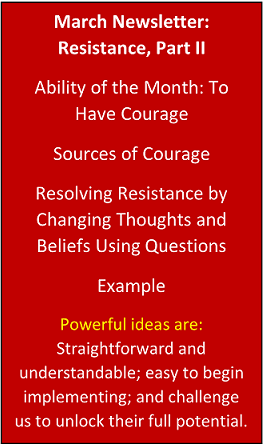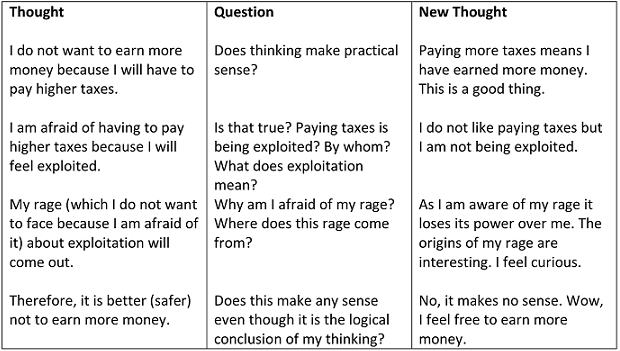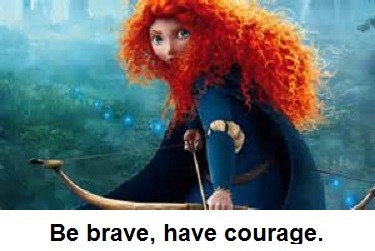 Resistance: The Blockage that Keeps Us from Being, Doing, and Having What We Want. Part II Pdf version
Resistance: The Blockage that Keeps Us from Being, Doing, and Having What We Want. Part II Pdf version
The February 2017 newsletter contains part I of Resistance.
In part I we defined resistance, talked about recognizing resistance, ![]() and discussed the role of fear in resistance. We showed that courage is necessary to overcome that fear. Courage is thus an ingredient of the process of overcoming resistance. This month we will explore courage further and discover how to resolve resistance.
and discussed the role of fear in resistance. We showed that courage is necessary to overcome that fear. Courage is thus an ingredient of the process of overcoming resistance. This month we will explore courage further and discover how to resolve resistance.
Ability of the Month: To Have Courage
We even need courage to acquire courage because courage takes us into the unknown, and the unknown scares us. Therefore, appreciate yourself for having the ability to find, to have, and to use courage. Acquiring courage involves recognizing that we need courage and seeking it from the sources of courage. We can state the affirmation: “I now seek, find, and acquire courage.” We then become aware of “pop ups”: opportunities to find courage (thoughts and feelings of courage) and situations where we put our courage into action.
Courage
Courage is the willingness to act even though we are afraid (experiencing fear).
Sources of Courage:
- In memories of past triumphs when we overcame fear
- In the intensity of our desire to have or to accomplish something
- In the vision of our happiness in the future
- In the sense of accomplishment and pride we will feel when we accomplish a goal
- In our desire to build our self-confidence by overcoming our fears
- In knowing that the change we seek will relieve some pain that we are feeling
- In the hope that our future will be better that our present
- In the knowledge that the benefit we will have in acting is greater that the risk involved, that the action is worth the risk
- In gifts from the transcendent: which come to us from our requests, from our prayers
Practice: Search for courage and recognize when it is present. Learn how to use courage by putting it into action when it comes to you.
Resolving Resistance
When we have recognized our resistance and found the courage to overcome our fear, we can take the next step: challenging the thoughts and beliefs that generate resistance. Beliefs are persistent thoughts that we hold over time about our self, our world, and about “how life works”. Most of the time we are not aware of how our beliefs and belief system function and influence our life.
We challenge our thoughts and the thoughts that make up our beliefs by asking questions like:
- Is this thought true?
- Does it make logical sense?
- Is it in my best interests?
- What might be an alternative thought?
- What is the belief that goes along with this thought?
- What is the feeling that goes with this thought?
- What is the message of this feeling?
- Why do I think this?
- Where did I get this thought/belief from?
- Where is this thought/belief leading me?
- What behavior has this thought led me to?
- What has this behavior gotten me?
- Is this what I want?
- What thought would give rise to a more productive behavior, a behavior that would get me more of what I want?
- What alternative thoughts could I consider and choose to hold?
- How would I put these thoughts into action?
Practice: Become aware of your thinking. Challenge your thoughts and beliefs. Generate alternatives, considering where the alternatives will lead you. Act on them. Use your courage.

Let’s consider the example we started last month. The thoughts, feelings and conclusion are:
- “I do not want to earn more money because I will have to pay higher taxes.”
- “I am afraid of having to pay higher taxes because I will feel exploited.”
- “My rage (which I don’t want to face because I am afraid of it) about exploitation will come out.”
- “Therefore, it is better (safer) not to earn more money.”
Challenging Thoughts with Questions, Developing New Thoughts, and Changing the Self-limiting Beliefs that Cause Resistance

This is an example of resolving a resistance. It also illustrates a more general process of changing any self-limiting thoughts and beliefs. This process is transformative, a model and procedure for accomplishing changes that you want.
Conclusion
We have taken quite a journey: from defining resistance, recognizing resistance, understanding fear and courage, and learning to take the necessary steps to resolve resistance.
Practice: Read and study this material. Put it into action to create what you want to be, do, and have for yourself and the world around you.

Want inspiration and strategies to tackle your resistance?
Consult The Operating Manual for the Self
Let’s unite in developing our human potential. Share this newsletter with others. Please visit our website, IIFSD.org. We invite you to participate, (as suggested in the Participation Menu selection). When you buy The Operating Manual for the Self (manualfortheself.com), you support our vision and mission. When you read The Operating Manual for the Self, you leap forward in your personal self-development and evolution.
Copywrite IIFSD.org, February 2017. All rights reserved.


